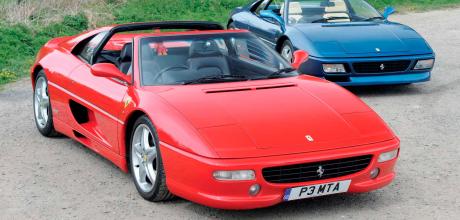1989 Ferrari 348 ts vs 1994 F355 GTS
Surely it’s not fair to compare the notoriously lambasted Ferrari 348 with its lauded successor, the F355? But could it be that the former is simply misunderstood – and maybe offers something that’s missing from its illustrious successor?
Story by Nathan Chadwick
Images by Michael Ward
Two Horse RaceCan the older 348 hold a candle to the F355?
One of the worst Ferraris ever made. That’s the opinion you usually hear of the 348, launched in 1989. And not just by pundits. Ferrari’s own CEO, Luca di Montezemolo, famously hated it after buying one as a customer. In a 2016 interview in Motor Sport magazine, he recalled: “I’m at the first meeting as CEO and I asked to be presented with our range, and they said ‘OK, we have the Testarossa, we have the 348 – very good car, innovative, eight cylinders’, and I said ‘Please stop. This is a shit car. So don’t say this to me; I am a client, I know what this car is like’.”

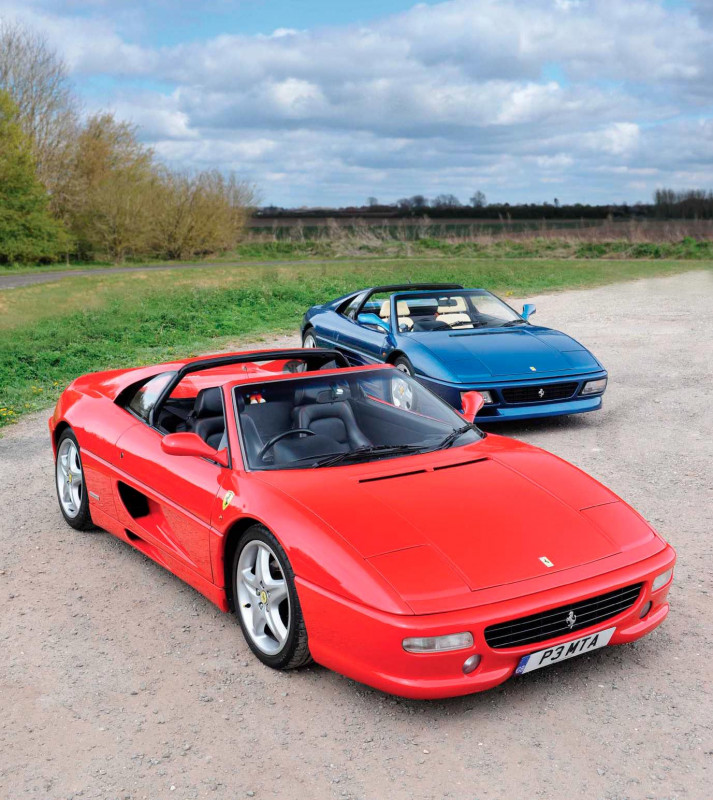
“The F355 is much more manageable in motion… a car you could use every day”
Its successor, the F355 of 1994, is regarded as a golden child. Eschewing the Testarossa-inspired style for free-flowing curves, the F355 looked good and was widely lauded in the press. It’s now feted as one of the finest mid-engined machines that Maranello has ever crafted.
But we’ve had a nagging feeling that the 348 might just be unfairly maligned – after all, it’s still a mid-engined Ferrari with a manual gearbox. Or does the F355 live up to the hype and justify the premium the market places on it? We’ve gathered targa-roof examples of the 348 and F355 together to see what’s up, and look behind the cut-and-paste internet opinions.
348: AN UNEXPECTED GREAT?
For all the downbeat opinions about the 348, it’s easy to forget how well this car was received back in the day. Equally pertinently, its 328 predecessor was actually a bit of a handful on the limit – a criticism often levelled at the 348. The 328’s engine sat transversely with the gearbox underneath it, which didn’t do wonders for the centre of gravity and thus its trustworthiness when hanging it out. Ferrari mounted the 348’s quad-cam, all-alloy 3.4-litre V8 longitudinally with the gearbox set transversely (hence the ‘t’ in 348 tb). As a result, the engine sat a full five inches lower – so low that our cratered car park photo location is giving my sweat glands a workout, and I haven’t even switched the engine on yet.
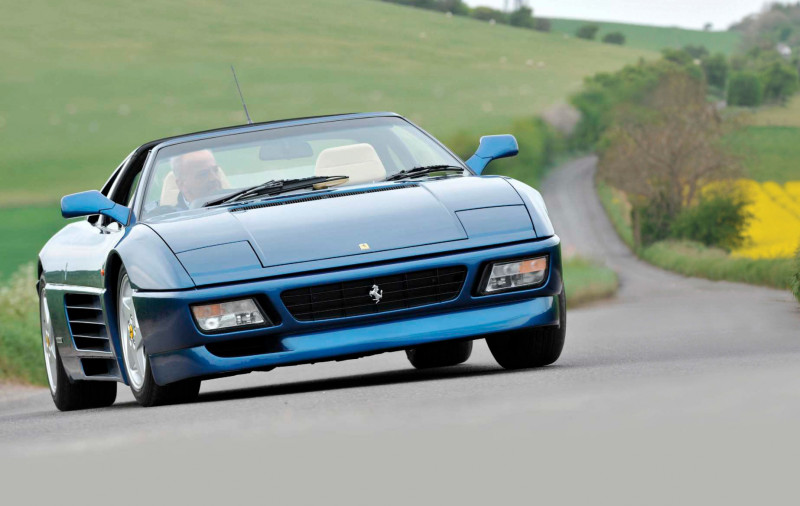
The 348 marked a new direction for Ferrari in that it abandoned spaceframe construction for a body formed of box sections, giving it 50 per cent greater torsional rigidity. The 348 tb was heavier than the old 328, tipping the scales at 1393kg (versus 1263kg). Yet its V8 engine had only 30hp more power and 15lb ft extra torque: the 348 had 300hp on launch (later upped to 320hp).
Not that contemporary journalists had much problem with the 348’s performance, or indeed the car itself. Aside from gripes about a turning circle akin to the average galleon, everyone seemed to love it. A fully beehive hairdo-era Jeremy Clarkson even treated his 348 test car to a romantic meal in a field. Like most other hacks, Clarkson later changed his tone and took great delight in slagging it off.
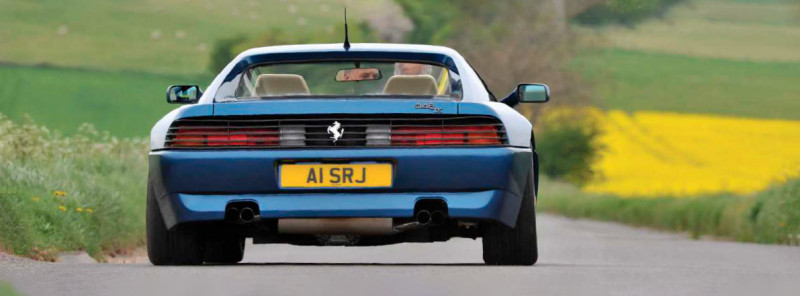
With its iffy reputation, the 348 has lingered in the lower depths of Ferrari values, only just above the Mondial. It’s still possible to buy a 348 for below £50,000. But as I write this, the unthinkable has happened. A low-mileage 348 is currently up for grabs for £90,000 – more than most F355s. Is this evidence that the 348 is finally coming out of the mire?
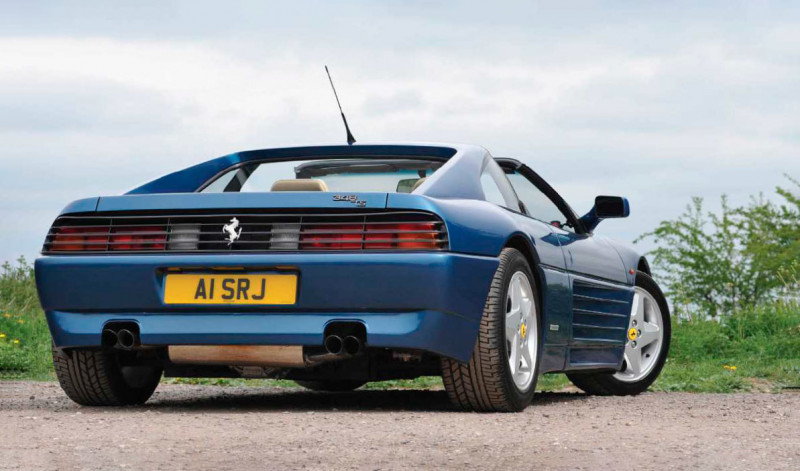
As I take in Rob Jones’ beautiful Blu Chiaro 348 ts, it’s difficult to see the arguments against. It’s stunning to behold. This might seem heretical to hardcore tifosi, but a lot of Ferraris look their best in any shade other than red (or yellow, for that matter). The blue metallic colour also enhances its subtle shape, with the slightly awkward flared rear haunches looking less pronounced.
However, Rob’s fitted a body-coloured front splitter and sideskirts, which does a great job of making the car look more exotic. Indeed, Ferrari itself did the same with the rare GTS ‘facelift’ 348.
But how does the 348 ts fare in terms of driving? There’s a certain sense of trepidation here. The 348 has a reputation for flinging its owners into the scenery, with tales aplenty of snap oversteer and resulting snapped bodywork. Getting up to speed, the 348 ts certainly doesn’t feel like a wild child. It’s simply old-school to drive. The rack-and-pinion steering is unassisted, which means its broad 39ft turning circle really wakes up your biceps. While not overly sensitive, it’s quick to respond and bristles with feedback about the road surface, firing information through your central nervous system.
The engine rouses the rest of you – there’s no avoiding soaking up the hard metallic rasp and instant throttle response, the rev needle zipping around the dial to a 7200rpm peak, particularly with the roof off. It’s the very essence of the supercar experience, your ears tingling to the eight cylinders singing their heart out. The gearbox, however, certainly isn’t smooth. It’s distinctly obstinate, particularly when engaging second gear. So far, so Ferrari; each gearshift requires a firm, well-planned and unrushed shove.
And what of the notorious handling and ride? After all, Ferrari acknowledged it got it slightly wrong when it launched the facelifted 348 GTS in 1993, which saw tweaks such as a wider rear track, revised geometry and extra chassis rigidity. Weight distribution was also improved. But does this really mean the 348 ts is more of plodding donkey than a prancing horse?
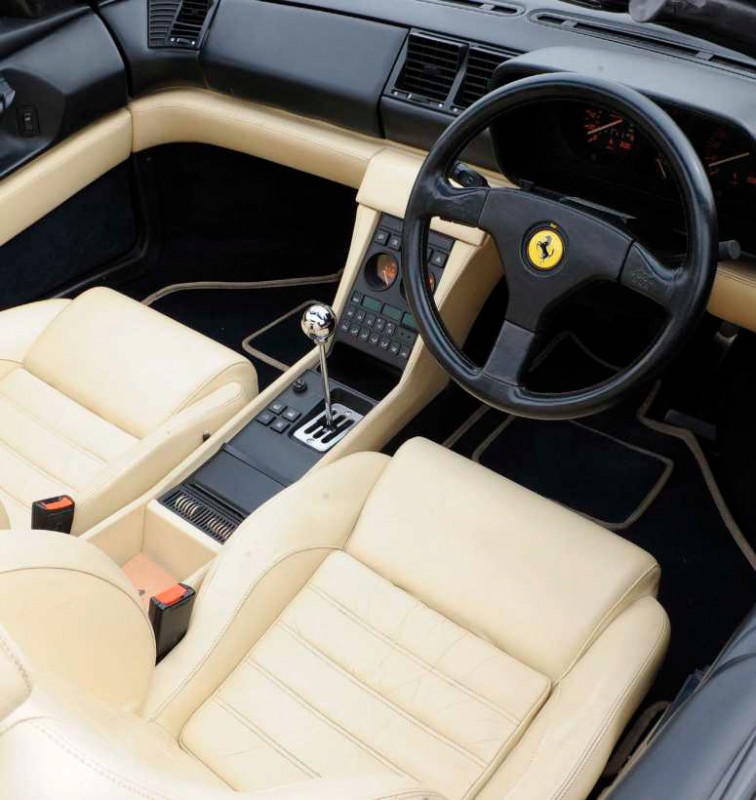
348 has a raw feel to it that makes it harder to live with but in some ways more exciting to drive.
Not a bit of it. It’s true, it doesn’t coddle you like an F355, and you feel that at the first corner. The aforementioned talkative steering allows you to plant the nose with precision, but rather than simply flyswat the throttle, you’ve got to meter the power in, feel the weight transfer. The 348 ts delivers its peak torque at 4200rpm, which means it doesn’t take much for the rear tyres to become over-excited if you’re not careful. With little in the way of driver aids to help you, you need to be sure of just what you’re doing. Don’t think that’s a bad thing – it’s what makes the 348 experience visceral and exciting; screaming and enticing; absorbing and rewarding. True, the ride is noticeably firm but way more compliant than any supercar of the last 10 years. This is a turn up for the books – the 348 isn’t damned; it’s damn good.
F355: STILL A LEGEND?
So how does the 348’s successor, the F355, feel in comparison? It’s certainly prettier than the 348: gone are the macho Testarossa-aping side slashes, and in come more resolved curves. It even looks great in red, too. Just four years separate Rob’s 1992 348 ts and Graham Godfrey’s 1996 F355 GTS, but the difference feels like more than a decade. It’s far less cramped inside, and with a cut-out central tunnel under the dash, there’s more room for my left leg. I can actually see most of the dials, too, which I can’t quite manage in the 348.
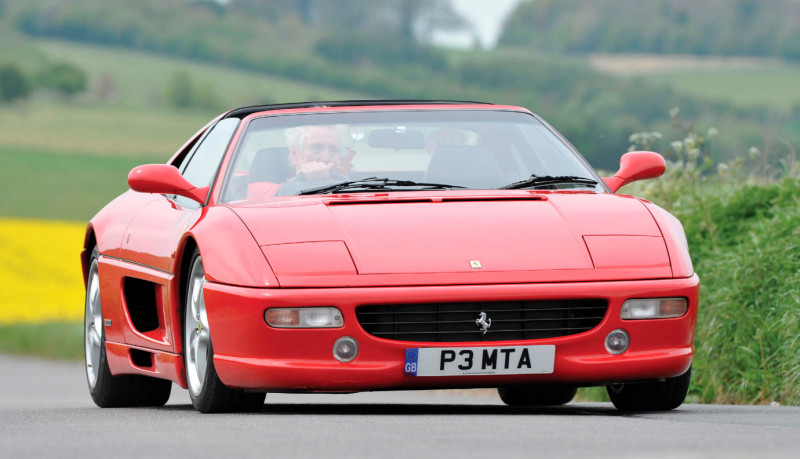
The F355 is also much more manageable in motion. Ferrari finally acquiesced and fitted power steering, courtesy of TRW. It’s a little lower geared than the 348’s, making cruising about much less of a constant mental calculation. The manual gearshift (now six speeds rather than five) is much smoother and in a traditional H-pattern, rather than the 348’s dogleg first. Even by modern standards, the F355 really does feel like a car you could use every day.
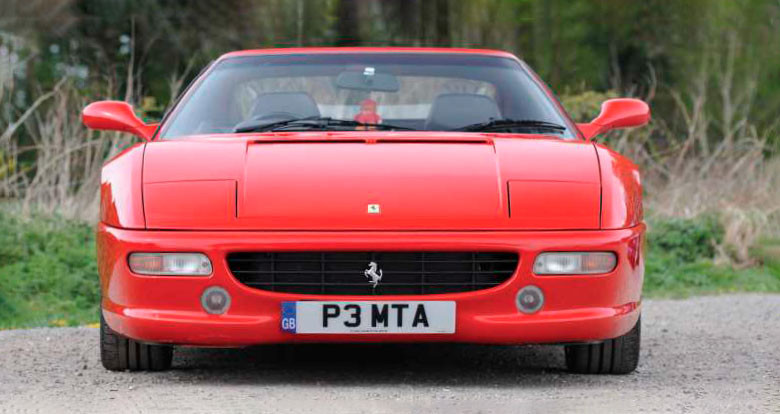
The thing is, though, the point of supercars is that they’re meant to make you feel super. To make an analogy with beverages, while your daily driver is a cup of tea, a supercar is a shot of vodka. Could the F355 be a bit too diluted?
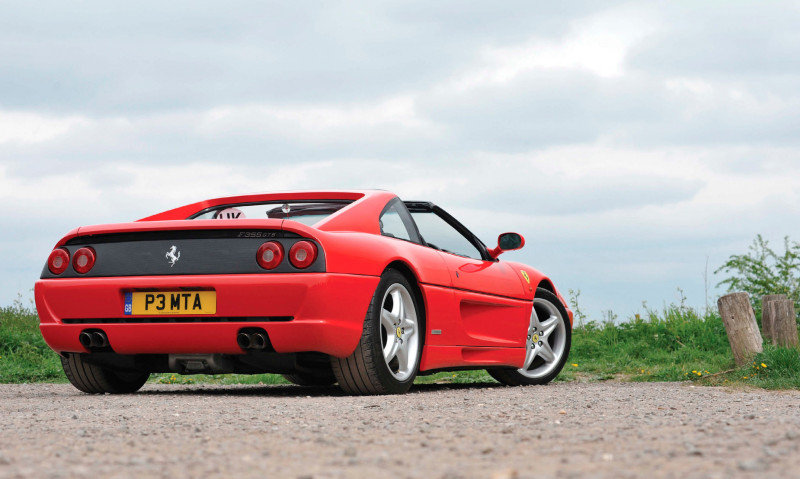
The V8 is a longer-stroke development of the 348’s unit, with a swept volume of 3496cc, up from 3405cc. New features included five valves per cylinder (versus four before), variable valve timing and hydraulically actuated tappets (a first in a Ferrari road car). The result was 380hp and a specific output of 109hp per litre, then a record for a naturally aspirated engine. The initial throttle response isn’t quite as instantaneous as the 348’s, but that does make it a bit easier to manage. Peak torque comes in at a lofty 6000rpm, 1800rpm higher than the 348, and it’ll scream up to and beyond 8000rpm. Get up there and you can feel each hair follicle twist and turn in the breeze as your right foot tries to play chicken with your sense of mortality. Of the two engines, it’s the F355’s that provide the greater theatrics.
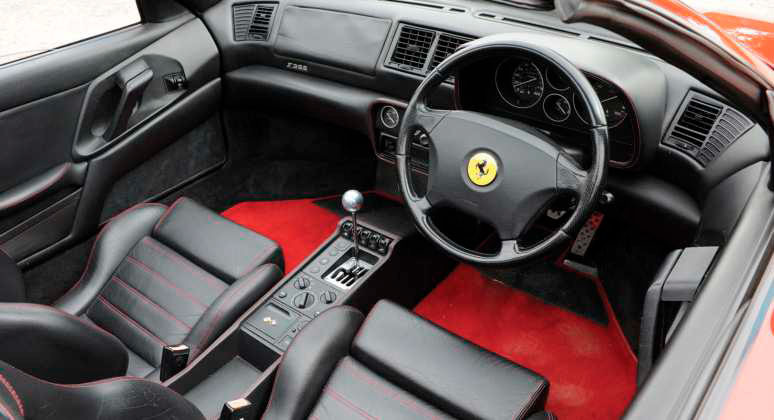
Better cabin offers easier driving position. Throttle response is less frenetic, handling more assured
In corners, the F355’s useability plays dividends. Coming up to a tight 90-degree bend, in the 348 I am already plotting what the rear end would be doing over a mid-corner bump, cajoling the gearshift into position and adjusting steering wheel accordingly. In contrast, the F355 simply tucks in at the front, the clever Bilstein adaptive dampers having a nano-second-length committee meeting to decide their attitude, and I can concentrate on liberating the engine fully on the next straight.
It’s such a shame that the steering robs you of fingertip-fizzing involvement. It’s still much more feel some than any of today’s electric steering systems, but swapping between the 348 and the F355 makes me yearn for that little extra edge of detail, excitement and engagement. There’s absolutely no doubt that the F355’s superior suspension compliance makes it the much faster car point to point, but perhaps paradoxically, going slower might just be a little more rewarding.
VERDICT
The fact that the F355 feels so great is hardly a surprise. It’s the poster car of a generation and is already a revered classic. The 348 was a much bigger challenge to my preconceptions – for years I had the impression that the 348 was the midengined Ferrari you’d buy if you couldn’t afford an F355. Instead, I found that the 348 stands up on its own as a superb driver’s car, offering a purer, more hardcore experience than the F355.
Don’t get me wrong, the F355 is a fantastic machine. If you’re doing regular long distances or want to enjoy a midengined Ferrari without having to consider every single facet of the road ahead to avoid things going horribly wrong, then of our two cars it’s the one to have. It’s so much more amenable to use, which probably means you’d use it more often. This is an assertion that’s backed up by those people who’ve owned both. It’s also the prettier, more coherent design.
And yet, as I type this, it’s the 348 that lives in my memory. Days later, it still makes my fingertips fizz. I can well understand why it was criticised – the heavy unassisted steering and obstinate gearchange, and throttle response so sharp that you have to be alert at all times – but this is surely how you should feel in a supercar.
Learning all this, adapting your driving style, becoming one with the 348, feels more rewarding. The more I got to grips with the gearshift, the more I felt the intricacies of the bitumen telegraphing up my arms, the more I wanted to drive it. The 348 is a supercar that feels challenging: there’s an endearing thuggishness about it that you’ll either get on with, or simply find too much.
It’s also a stupendous bargain right now. A good 348 ts starts at little more than £50k, while the better-developed GTS/GTB starts at around £65k. In contrast, you’d be spending at least £80k and probably a lot more for an equivalent manual-gearbox F355. Some would see the F355’s sheer useability, looks and established market acceptability as more than worth the premium, and that’s understandable. But as I type this, thinking of a dawn blast on my favourite B-road, it’s the granular analogue excellence of the 348’s steering that’s quickening my pulse. And I’d have a spare £15k to wax on super unleaded.
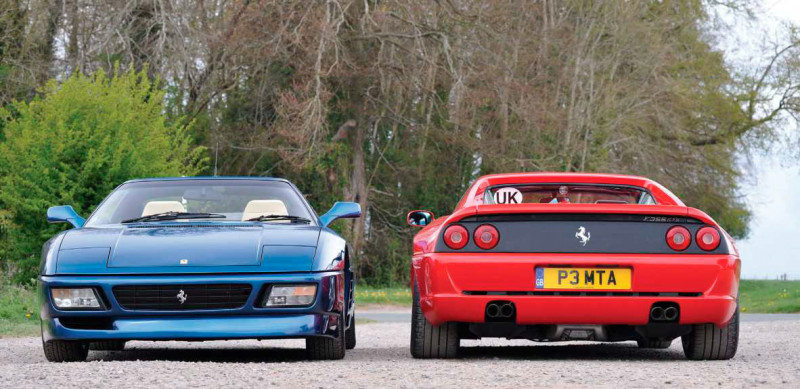
Thanks to Graham Godfrey, Rob Jones, Richard Dredge and the Ferrari Owners Club UK ferrariownersclub.co.uk
TECHNICAL SPECIFICATIONS FERRARI 348 TS / FERRARI F355 GTS
- ENGINE: 3405cc V8 32v DOHC / 3496cc V8 40v DOHC
- COMPRESSION RATIO: 10.4:1 / 11:1
- POWER: 300hp at 7200rpm / 380hp at 8250rpm
- TORQUE: 323Nm (238lb ft) at 4200rpm / 363Nm (268lb ft) at 6000rpm
- TRANSMISSION: 5-speed manual, RWD / 6-speed manual, RWD
- WEIGHT: 1390kg (dry) / 1350kg (dry)
- MAX SPEED: 171mph / 183mph
- 0-62MPH: 5.6sec / 4.7sec


